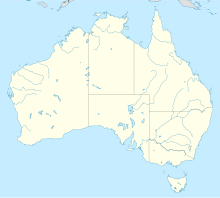Agnew Gold Mine
| Location | |
|---|---|
 Agnew Location in Australia | |
| Location | Agnew |
| State | Western Australia |
| Country | Australia |
| Coordinates | 27°59′35″S 120°29′45″E / 27.99306°S 120.49583°ECoordinates: 27°59′35″S 120°29′45″E / 27.99306°S 120.49583°E |
| Production | |
| Production | 192,100 |
| Financial year | 2008-09 |
| Owner | |
| Company | Gold Fields Limited |
| Website | www |
| Year of acquisition | November 2001 |
The Agnew Gold Mine, formerly the Emu Mine, is a gold mine located 3 km (1.9 mi) west of Agnew, Western Australia. It is owned by the South African mining company Gold Fields.[1] It is one of two mines the company operates in Australia, the other being the St Ives Gold Mine.
Ore is mined at Agnew in the under ground Waroonga complex and the open pit Songvang operation.[2]
History[]
Western Mining - WMC, discovered the Agnew gold deposit in the early 1980s.[3] A second gold mine in the area, the Lawlers Gold Mine, is operated by Barrick Gold.
On 13 June 1989 the mine, then called the Emu mine, was the scene of one of the worst mining disasters in Western Australia when six workers drowned in the underground operations during a flood.[4][5]
The mine was purchased by Goldfields from WMC in late 2001.[6][7] The combined price for the two Australian operations Goldfields purchased, St Ives and Agnew, was US$180 million in cash and $52 million in Gold Fields shares.
Agnew, as of 2009, employees 114 permanent staff and 298 contractors.[2]
A 4 MW solar farm was added in 2019,[8] along with a 17 MW wind farm and a 13MW/4MWh battery,[9] supplying half the mine's power needs.[10]

Production[]
Annual production of the mine:
| Year | Production | Grade | Cost per ounce |
| 2000[6] | 209,598 ounces | 6.27 g/t | |
| 2001[6] | 185,400 ounces | 6.08 g/t | |
| Jan to June 2002[6] | 66,200 ounces | 3.56 g/t | A$436 |
| 2002-03[11] | 144,000 ounces | 3.5 g/t | A$437 |
| 2003-04[11] | 202,000 ounces | 5.3 g/t | A$317 |
| 2004-05[11] | 212,500 ounces | 5.6 g/t | A$315 |
| 2005-06[2] | 222,000 ounces | 5.2 g/t | A$370 |
| 2006-07[2] | 212,000 ounces | 5.0 g/t | A$380 |
| 2007-08[2] | 204,000 ounces | 4.8 g/t | A$496 |
| 2008-09[12] | 192,100 ounces | 5.6 g/t | A$541 |
| 2009-10 |
Sources[]
- The Australian Mines Handbook: 2003-2004 Edition, Louthean Media Pty Ltd, Editor: Ross Louthean
- Western Australian Mineral and Petroleum Statistics Digest 2008 Page 34: Principal Mineral and Petroleum Producers - Gold
References[]
- ^ Agnew, Australia, Gold Archived 2012-07-17 at archive.today AME Mineral Economics website, retrieved 2009-08-09
- ^ a b c d e Review of International Operations - Agnew Gold Mine Archived 2009-09-12 at the Wayback Machine Goldfields website, retrieved 2009-08-09
- ^ Western Mining Corporation Ltd Guide to Australian Business Records, retrieved 2009-08-09
- ^ "Miners injured in collapse at underground gold mine". ABC News. 10 January 2012. Retrieved 10 November 2021.
- ^ Torlach, J M (10 April 1990). "SIGNIFICANT INCIDENT REPORT NO. 11: EMU MINE DISASTER" (PDF). Department of Mines, Western Australia. Archived from the original (PDF) on 1 June 2013. Retrieved 10 November 2021.
- ^ a b c d The Australian Mines Handbook: 2003-2004 Edition, page 65
- ^ News briefs Mining Engineering magazine, published 2001-11-01, retrieved 2009-08-09[dead link]
- ^ Mazengarb, Michael (20 November 2019). "First stage of unique solar-wind-battery hybrid project opens at Agnew gold mine". RenewEconomy.
- ^ Vorrath, Sophie (5 December 2019). "Huge wind turbine parts complete 630km journey to ground-breaking microgrid". One Step Off The Grid.
- ^ Vorrath, Sophie (5 November 2021). "Australia's biggest renewable microgrid powers gold mine up to 85%". RenewEconomy. Archived from the original on 5 November 2021.
- ^ a b c Annual Report 2005 Gold Fields website, retrieved 2009-08-10
- ^ Quarterly report June 2009 Goldfields website, retrieved 2009-08-10
External links[]
- Gold mines in Western Australia
- Underground mines in Australia
- Surface mines in Australia
- Goldfields-Esperance
